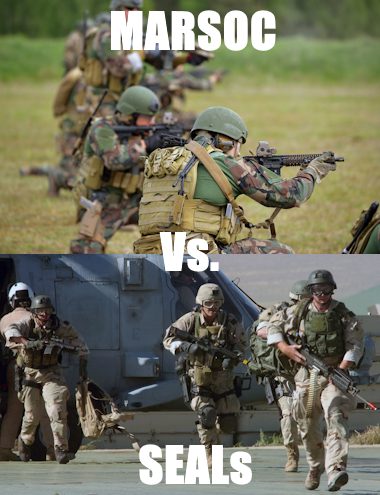MARSOC vs SEALs?
There are many who are familiar with U.S. Navy SEALs, yet few know much about Marine Raiders (MARSOC).
It’s unfortunate, considering that both special operations forces are integral to the U.S. military as well as keeping the world safe.
Discover what makes Marine Raiders (MARSOC) and Navy SEALs different from each other.
Related Article – MARSOC Vs. Navy SEALs, Green Berets, & Marine Recon
Marine MARSOC vs Navy SEALs: 6 Differences
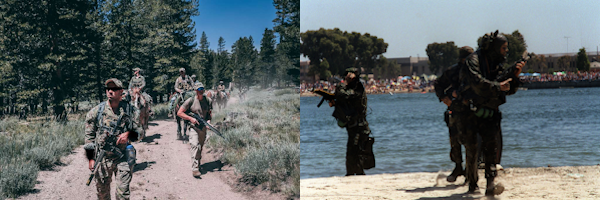
Who wins in the debate: MARSOC vs SEALs?
Marine Raiders (MARSOC) have a proud history and are one of the original special forces present during World War II.
Meanwhile, U.S. Navy SEALs are among the most well-known and respected military forces in the world.
However, several differences exist between the two elite special forces, including:
- Purpose
- History
- Structure / Organization
- Requirements / Qualifications
- Military (SOF) Training
- Weapons & Gear
Learn more about the 6 major differences between Navy SEALs and Marine MARSOC Raiders:
#1. Purpose
MARSOC vs SEALs?
First, it helps to understand the purpose of each special forces regiment.
Marine MARSOC and Navy SEALs operate under different branches of the U.S. Armed Forces and chains of command.
Marine Raiders (MARSOC)
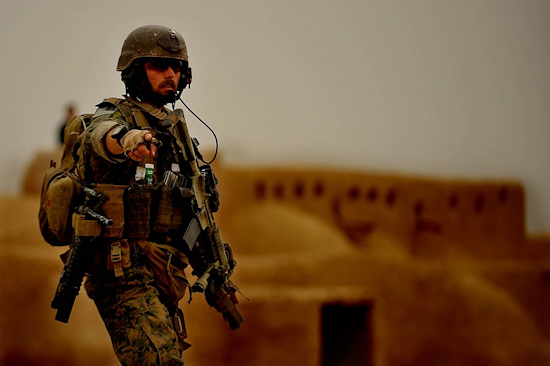
Marine Raiders comprise a group of special operations forces (SOF) with a history that dates back to WWII (more details, below).
The purpose of the military unit is to provide “amphibious light infantry warfare.”
In other words, these Marines are highly trained and capable of serving in land, water, or air operations.
Today, the Marine Special Operations Regiment serves under the United States Marine Corps Forces Special Operations Command (MARSOC).
MARSOC is a component of the United States Special Operations Command (SOCOM).
Its primary capabilities include direct action, special reconnaissance, and foreign internal defense.
Therefore, Marine Raiders are involved in many different roles which have only been expanded since the Global War on Terrorism.
As such, MARSOC also assists with counter-terrorism and information-gathering operations.
Raiders are considered “universal specialists” who are usually fluent in a second language and possess other special skills.
U.S. Navy SEALs
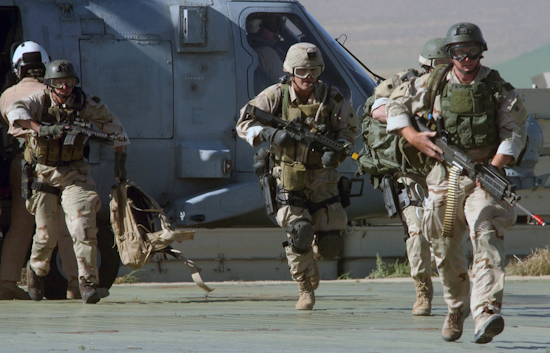
Navy Sea, Air, and Land (SEAL) Teams are among the most elite special forces in the world.
SEALs perform special operations in a variety of dangerous and remote locations.
These operatives are very well trained with the ability to conduct military operations on land, air, or sea.
They provide many different functions from direct action to counter-terrorism to reconnaissance.
Often, SEALs are ordered to capture or eliminate high-level targets.
Moreover, SEALs are frequently assigned to surveillance and intelligence-gathering behind enemy lines.
These elite, small-team units are hand-selected after surviving rigorous military training (more information, below).
Navy SEALs are composed of several different units including the world-famous SEAL Team 6 (DEVGRU).
Furthermore, some elite Navy SEALs are offered additional opportunities to serve in top-secret special forces like the CIA Special Operation Group (SOG).
So, while Navy SEALs and MARSOC Raiders have some similarities they also usually have slightly different roles in military operations.
#2. History
Interestingly enough, Marine Raiders are considered one of the first special forces in the history of the U.S. military.
The beginning of World War II created a dilemma for the Fleet Marine Force, which lacked transport ships that could keep up with the rest of the Naval fleet.
As such, the other ships in the fleet would have to reduce speed or split into two different components to keep the transport ships protected.
Neither option was desirable, which prompted President Franklin D. Roosevelt to establish his own version of British Commandos.
President FDR’s vision was that these elite commandos could assist with the raids being conducted on the tightly defended Japanese islands.
As a result, Marine Raiders were born and initially consisted of 2 different battalions.
Marine Raiders were handpicked from a pool of available volunteers and received the best weapons and gear at the time.
However, the idea was short-lived, and Marine Raiders ceased to exist after World War II.
Post 9/11 World
However, in the early 21st century, the idea of a Marine Raider was revised due to the ensuing Global War on Terrorism.
For this reason, the U.S. Armed Forces established the Marine Corps Forces Special Operations Command (MARSOC).
It began with Detachment One (see, Military Structure), which was designed to pay homage to the original Marine Raiders.
The extraordinary success of early MARSOC units has led to the evolution of additional teams that exist under its command.
Since then, MARSOC has played an important role in Iraq, Afghanistan, and other regions of the world.
Today, Marine Raiders remain an integral part of SOCOM and assist in many joint operations.
Navy SEALs, meanwhile, do not have quite the extensive history as Marine Raiders, although they also have origins dating back to WWII.
Nevertheless, the elite special operations force was not officially established until 1962 by President John F. Kennedy.
The early training at the Navy Amphibious Scout and Raider School takes much inspiration from the original Raiders.
Today, Navy SEALs are one of the most recognizable elite special forces in the world.
They serve in many top-secret and highly confidential military roles, with one of the most prominent being the raid that led to the death of Osama bin Laden.
#3. MARSOC vs SEALs: Structure / Organization
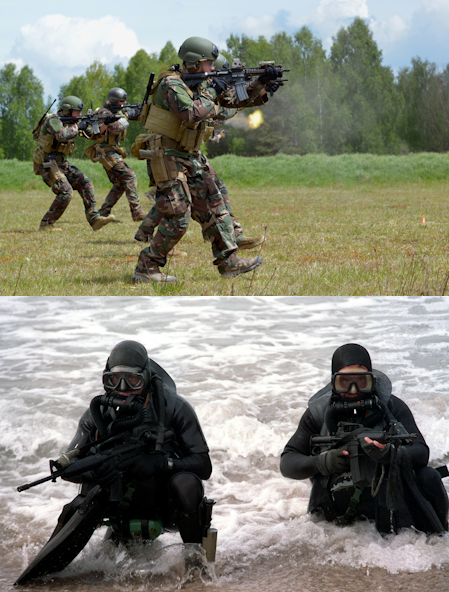
Navy SEALs and Marine Raiders each feature their own unique structure and organization.
Marine Forces Special Operations Command (MARSOC)
Marine Forces Special Operations Command (MARSOC) is based out of Camp Lejeune in North Carolina.
The basic unit of MARSOC is a 14-man Marine Special Operations Team (MSOT).
The MSOT team is commanded by a Captain (team commander) and assisted by a Master Sergeant (team chief).
Then, each team features 2 identical squads (tactical elements) led by a Gunnery Sergeant (element leader).
The subordinate commands of MARSOC include the Marine Raider Regiment (MRR) and Marine Raider Support Group (MRSG)
The battalions that serve under MRR are tasked with direct action, special reconnaissance, and counter-terrorism.
Meanwhile, the Marine Raider Training Center (MRTC) and MRSG assist with education and training, including becoming proficient in a second language.
Marine Raiders also provide military training to friendly, foreign nations.
Finally, MARSOC personnel are divided into the following military roles:
- Marine Critical Skill Operators (CSO)
- Special Operations Officers (SOO)
- Special Operations Capabilities Specialists (SOCS)
- Special Operations Combat Service Specialists (SOCS-S)
Marine Critical Skill Operators (CSO) are the primary special operations within MARSOC.
These operatives learn a second language and other means necessary for crossing cultural barriers and working with allied forces.
Naval Special Warfare Command (NSWC)
United States Navy SEALs are divided into several different teams and groups.
The Naval Special Warfare Group 1 consists of 4 special-ops teams and is based on the West Coast (Coronado, California).
Meanwhile, Naval Special Warfare Group 2 operates out of the East Coast (Little Creek, Virginia) and also consists of 4 different teams.
Then, there are also Navy SEAL Special Boat Teams and Delivery Vehicle (SDV) Teams conceived for joint expeditionary operations.
Additionally, Navy SEAL teams are assembled specifically for special reconnaissance.
Lastly, the Naval Special Warfare Development Group (DEVGRU) is perhaps the most well-known.
DEVGRU (also known as Navy SEAL Team 6) consists of 6 different squadrons.
These squadrons are further divided into 16-man platoons that can be organized into two different 8-man squads (direct fire or sniper/reconnaissance teams).
Navy SEAL Team 6 consists of some of the best-trained operatives and is deployed all over the globe.
#4. Requirements / Qualifications
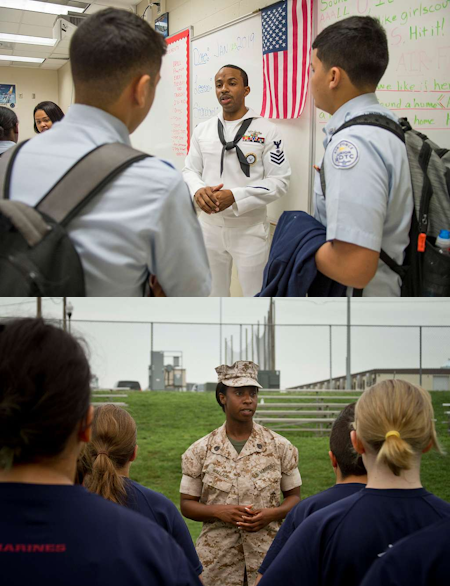
It’s not easy to become a Navy SEAL or Marine Raider.
However, with the right focus and determination, anything is possible.
Those interested in joining MARSOC must meet several basic requirements, including:
- U.S. citizen
- High school diplomma (or GED)
- Minimum GT score of 105 (ASVAB)
- Minimum PFT (physical fitness) score of 235
- Complete the MARSOC Swim Assessment
- Pass the MARSOC Medical Screening
MARSOC Raiders, like Navy SEALs, must be eligible to obtain and maintain a security clearance.
Thus, the prerequisites usually involve an extensive background check investigation.
The screening process usually takes place in 3 stages (background check, physical screening, medical and psychological evaluation).
Meanwhile, the requirements to become a U.S. Navy SEAL are not any easier.
New recruits, like MARSOC applicants, are subject to an extensive background investigation.
Additionally, they must be U.S. citizens (between the ages of 17 – 28) that are capable of passing a medical examination for diving.
Minimum ASVAB scores for Navy SEALs are:
- GS+MC+EI=170, or
- VE+MK+MC+CS=220, or
- VE+AR=110 MC=50
The U.S. Navy Physical Screening Test (PST) also requires that candidates meet the following qualifications:
- Run 1.5 miles (under 10:30)
- Complete a 450-meter swim (under 12:30)
- Complete 42 push-ups, 50 sit-ups, and 6 pull-ups
However, these are just the initial steps in becoming a Navy SEAL or MARSOC Raider.
Candidates for both special forces must survive and complete military training, easily the hardest step in the selection process.
Related Article – Navy SEALs vs Marines
#5. MARSOC vs SEALs: Military Training
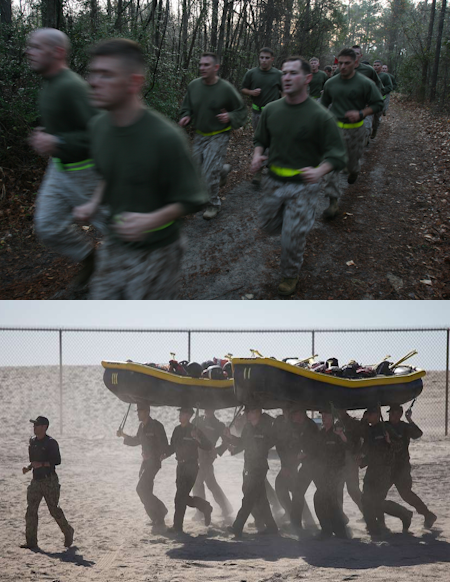
There are many who consider Navy SEAL training among the most difficult and strenuous in the world.
In fact, the washout rate among new recruits is so high that 3 in 4 candidates do not make it past the training program.
In general, approximately 880 candidates start Navy SEAL training each year with about 170 making it through training.
Navy SEAL Training
Navy SEAL training is legendary and features notorious aspects like “Hell Week” and Survival, Evasion, Resistance, and Escape training.
Most of the training exercises incorporate teamwork and deal with extreme weather or environments, like underwater diving operations.
Navy SEAL candidates must complete the following training programs:
- Naval Recruit Training (10 weeks)
- Naval Special Warfare Prep School (8 weeks)
- Basic Underwater Demolition BUD/S Training (24 weeks)
- SEAL Parachute Jump School (5 weeks)
- Navy SEAL Qualification Training Program (26 weeks)
Navy SEAL BUD/s Training is especially notorious as is the Parachute Jump School.
The rigorous military training features little sleep, brutal physical conditioning, and self-induced hypothermia.
All in all, the initial training phase takes more than a year to complete with an additional 1-2 years of advanced training required depending on the specialty.
The military training for Navy SEALs is so grueling that recruits have died during the exercises.
MARSOC Training
The official website states that MARSOC equips and trains Marines to succeed in adverse weather conditions and against a wide range of adversaries.
For this reason, the Special Operations Training Course (SOTC) is one of the highlights of the training regime.
The Assessment and Selection (A&S) process consists of 6 weeks of non-stop, realistic challenges designed to evaluate and select candidates for Raider training.
MARSOC Raiders specialize in advanced weapons training along with Survival, Evasion, Resistance, and Escape (SERE) training.
Once Marines are selected for the program, they begin the Individual Training Course, which takes about 9 months.
All in all, the training regime goes something as follows:
- Basic Special Operational Skills (10 weeks)
- Small Unit Tactics (8 weeks)
- Close Quarters Battle (5 weeks)
- Irregular Warfare (7 weeks)
- Basic Language Course (10 weeks)
#6. MARSOC vs Navy SEALs: Weapons & Gear
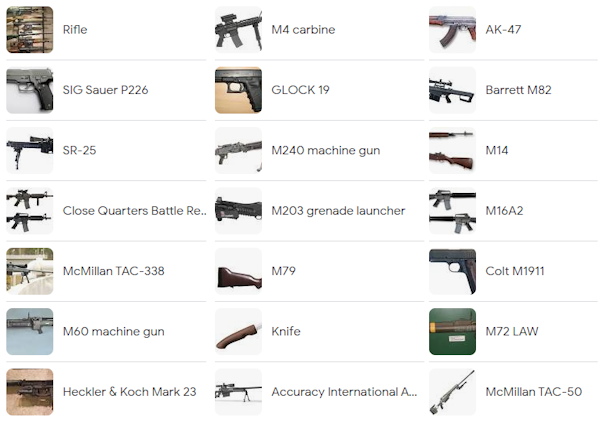
The weapons and gear of Marine Raiders have evolved since its foundation in World War II.
Today, military special operators have access to some of the finest weapons and tactical gear in existence.
The gear includes sophisticated, high-tech helmets, night vision, body armor, and other accessories.
The arsenal for Marine Raiders is impressive, including the MK-18 SBR and Glock 19.
Then, there are the weapons and gear of Navy SEALs which is reportedly one of the most expensive ever assembled for special forces.
The weapons and gear include highlights like the MK18 CQBR, M91A2 Sniper Rifle, and M2 Machine Gun.
Furthermore, Navy SEALs recently upgraded its primary sidearm from the Sig Sauer P226 to the Glock 19.
Navy SEALs also carry many different explosives and tactical gear designed to keep them safe and protected during combat operations.
It’s difficult to argue which arsenal is more elite as they are both impressive and easily cost more than $35K per operative.
Conclusion
It’s difficult to determine which regiment is considered the most elite since they both provide many of the same functions.
Marine Raiders and Navy SEALs are both very well-equipped and trained to handle a variety of military operations.
As such, Navy SEALs and MARSOC Raiders perform tasks related to direct action, special reconnaissance, and counter-terrorism.
Marine Raiders have become one of the more visible special forces in the wake of September 11 and the War on Terror.
On the other hand, the legacy and notoriety of Navy SEALs is arguably second to none.
- Ikon Pass Military Discount: Learn How To Save Big - January 31, 2025
- RTIC Military Discount: Find Out How To Save Big on Gear - January 30, 2025
- Traeger Military Discount: Learn How To Save Big on Smokers - January 28, 2025

